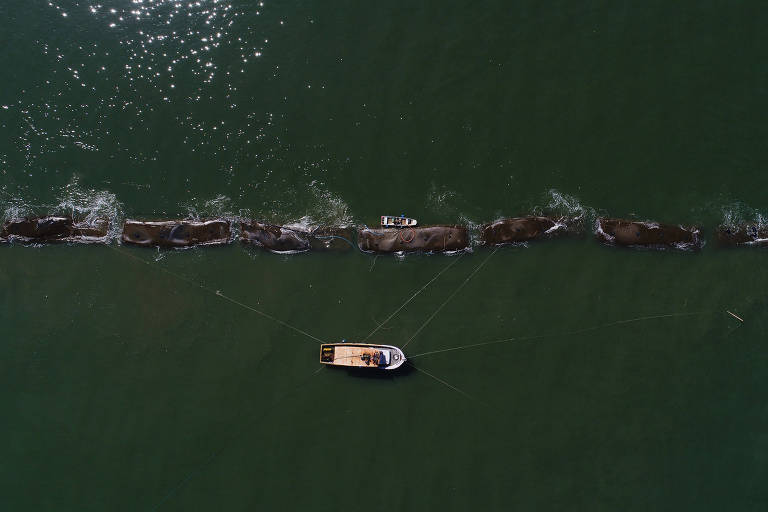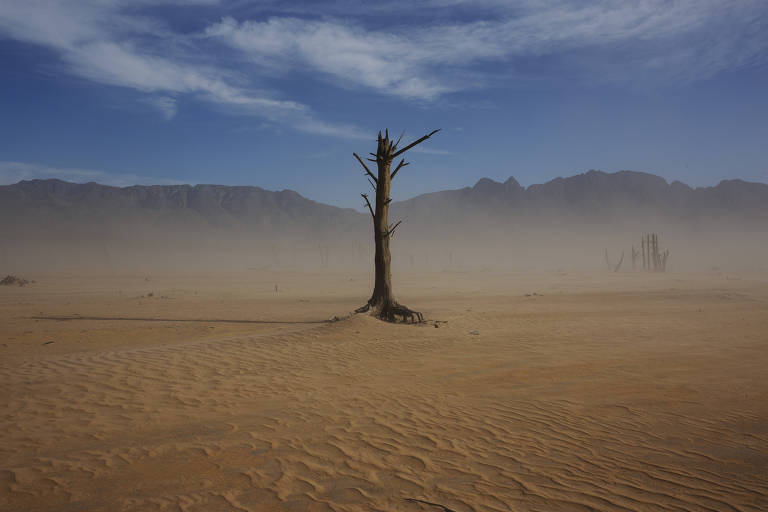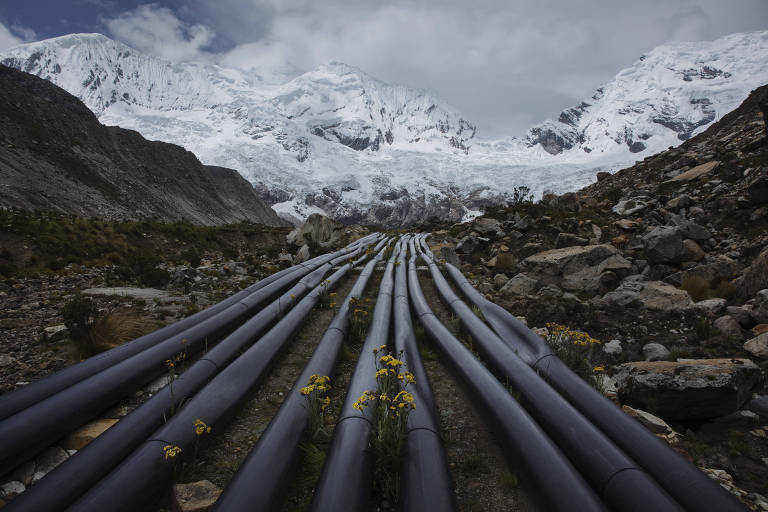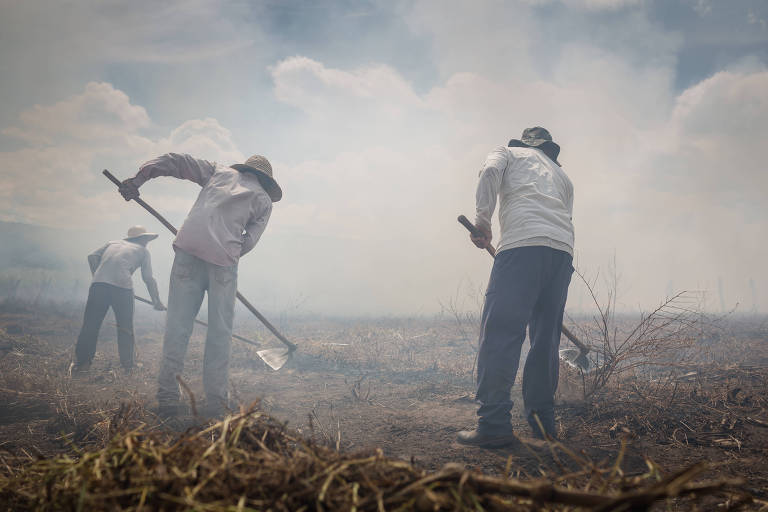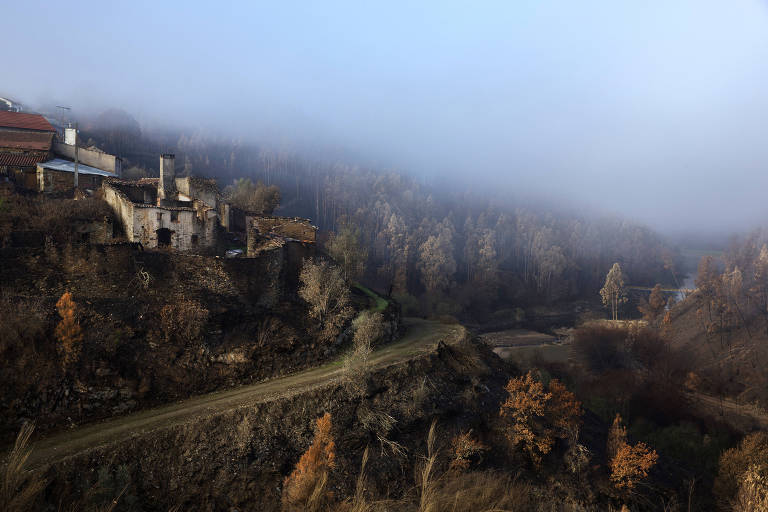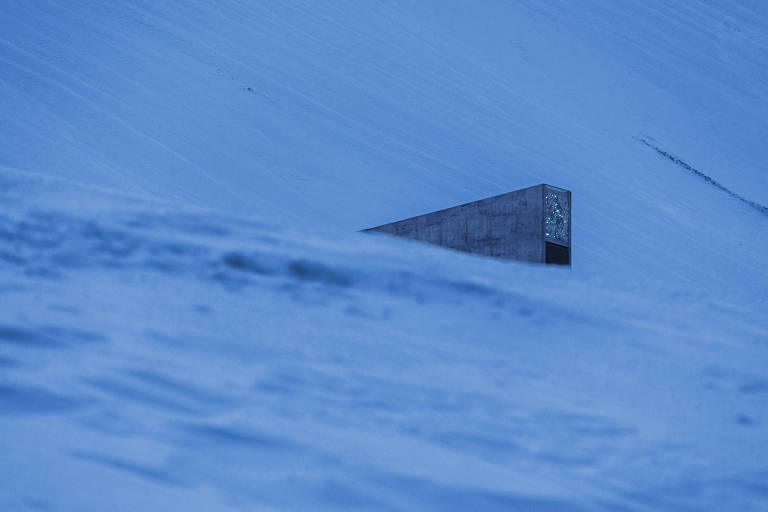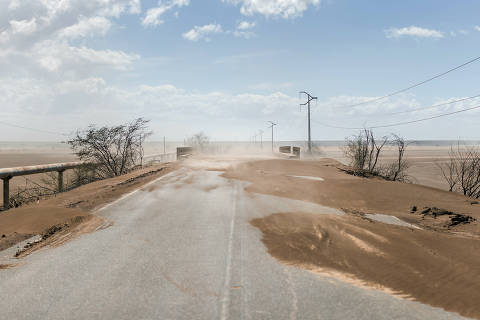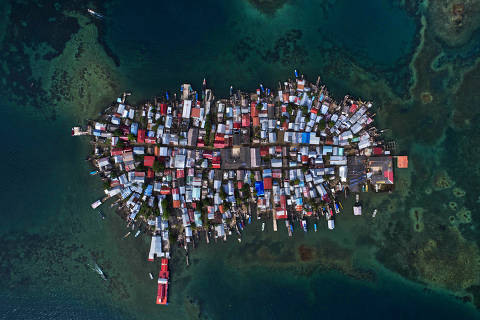Drought and the legacy of apartheid create panic over the prospect of dry taps on 'Day Zero'
5.jun.2018 - 02h00
{{video=3}}
{{lang=1|por,//staging.arte.folha.com.br/ciencia/2018/crise-do-clima/cidade-do-cabo/|esp,//arte.folha.uol.com.br/ciencia/2018/crisis-del-clima/ciudad-del-cabo/}}
On the first Sunday in May, a hundred or so Cape Town residents waited their turn in two orderly lines to fill water containers at the SAB brewery. On this sun-filled morning, people of varying skin hues did not seem convinced that the specter of Zero Day had been definitively averted with the arrival of the rainy season.
The company had installed a number of spigots in order to tap the water from the natural spring in the affluent Newlands neighborhood. Even with water at home, it was as if people were preparing for the drastic measures the government would take on Day Zero: cutting home water supply, forcing Capetonians to fetch their daily ration of 25 liters (6.6 gallons) at one of the 200 collection points to be set up throughout the city.
The prospect of such a scenario had been looming over the population for the past six months, but, in the end, implementation of the plan was called off by city authorities. After moving the date forward to May, then to June and then August, vice-mayor Ian Neilson announced in early April that any water Armageddon would not arrive before 2019.
{{video=1}}
By that time, residents had already lost confidence in the quantity and quality of water supplied by the city. They had also become disenchanted with Mayor Patricia de Lille, who had struggled to avoid being removed from office amidst a cloud of corruption accusations.
Not to mention that consumption at present continues to be limited to 50 liters (13.2 gallons) per person per day and water prices are still on the rise.
Patricia Kazaka, a media company manager, braces for her 15-minute wait in line with her two smaller children in tow. Her third, older, child assists with the five five-liter (1.3-gallon) containers. Kazaka has made the trek to the spring every Sunday after church since February in order to ensure that her family has clean water.
"There were some incidents with people drinking water from their tap at home getting sick," she says. The city government released a statement saying that the water was safe, but authorities also announced that tests were being conducted.
"That scared us a bit," she continues. "Maybe we should start buying water, but eventually every bottle adds up to a little more money, and we realized that we could get our water for free."
{{imagem=1}}
Kazaka and her family live in a house with a yard, but they are no longer able to water it. The monthly bill, which had ranged from 800 to 1,200 rand (roughly $60 to $100), doubled.
"I think the [Day Zero] campaign was necessary," she says. "Because if it weren't for the campaign a lot of us wouldn't probably start to realize how important it was to save water and teach our children not to flush or when to flush."
{{info=2}}
Several meters behind Kazaka, anthropologist and yoga teacher Kate Ferguson says she plans to keep coming to the water station, even if authorities say the reservoirs have filled again. She was just getting 15 liters (4 gallons) but says she comes regularly and always keeps containers in her car to maintain a safe supply.
"We want to take pressure off the city's water supply, the more people who come here to get their cooking and drinking water, the better," she says. Ferguson thinks the Day Zero campaign is a good idea. "In one way it was very clever. It brought consciousness to people's minds that water is a scarce resource, especially here at Western Cape in South Africa."
On the other hand, Ferguson considers water a basic human right, and complains that there is not enough pressure placed on the beef industry, which consumes enormous amounts of water. "The morality with which our leadership deals with things comes into question," she observes. "They instill fear on a basic right of citizens."
{{imagem=3}}
While the region surrounding Cape Town is not classified as arid, rainfall amounts can vary greatly in a 100 km (62 miles) radius. Certain parts of the metropolitan area get less than 400mm (about 16 inches) per year, comparable to Brazil's semi-arid Northeast. In the winter, the area is dependent on six large reservoirs for its water supply.
The reservoirs collect water from the mountains to the east, which can receive up to 2,000 mm (nearly 80 inches) of precipitation annually. But orographic rainfall (when moist air is lifted as it moves over a mountain range, resulting in condensation and rain) only occurs in the winter months, particularly in July and August.
October to May brings the dry weather typical of a Mediterranean climate. This is the exception in South Africa, which facilitated the cultivation of vineyards in areas surrounding Stellenbosch and Franschhoek in the Western Cape, as well as fruit-bearing trees –especially apple and pear– crops now under threat.
{{info=1}}
There have been severe droughts in the past, separated by intervals of four decades or so, but none compare to the dry period of the past three years. Piotr Wolski, a hydro-climatologist at the University of Cape Town, estimates that this type of event occurs only once every 300 years or more.
Wolski cannot be certain that the record drought is a direct result of climate change caused by warmer global temperatures. He sees a "very strong departure" from normal climatic conditions, which appears to be reinforcing a downward tendency in the amount of rainfall over the past 40 years.
{{video=2}}
{{imagem=14}}
Wolski points out that when evaluating data over the past century, no clear trend emerges, however. "The results are not robust at this stage," he says. "Perhaps in a couple of months we are going to have better results."
His gut tells him that climate change has contributed to the extreme drought conditions, but that the natural variability of the climate in the Western Cape is still the primary driving factor upon which climate change is superimposed. "It is a very difficult message to give," he adds, "because the whole world is looking at Cape Town this very moment, climate scientists and climate denialists."
In early 2017, when the drought was already in full swing, researchers assembled to present recommendations to the municipal government but were unable to reach a consensus on a forecast for the rainy season. In the end, they advised adhering to a conservative, risk-averse strategy.
Faced with this uncertainty, the municipal government failed to act, at first. Toward the end of last year, the precarious state of the city's reservoirs brought confirmation that the scientists had been right to recommend a cautious approach. This is the point at which people began to talk about a Day Zero.
{{imagem=4}}
In the summer of 2016-2017, water levels in the reservoirs fell 1.5 percent per week. Municipal authorities set the threshold of 13.5 percent capacity as a the trigger for declaring Day Zero, and first estimates indicated that it would happen in April.
A city that had been consuming 1.2 billion liters (317 million gallons) per day saw its water rationing reduced to 480 million liters (127 million gallons) per day by the national government. With the combination of an alarmist Day Zero campaign, higher rates for water consumption and the specter of dry taps, Cape Town managed to cut its water usage to 505 million liters per day, still above the target of 450 million liters (119 million gallons).
Rationing was set at 50 liters (13.2 gallons) per day per person (about one sixth of the 80 gallons Americans consume on a daily basis). Posters recommended less toilet flushing and doing so only for solid waste, taking sponge baths or even forgoing bathing altogether once per week.
There was a rush to expand the city's water collection capacity by drilling artesian wells and building four desalination plants, due to be completed in June. The desalination facilities would only add, at most, 20 million liters (5.3 million gallons) per day, and the aquifers 150 million liters (40 million gallons) daily.
{{imagem=5}}
Ian Neilson, the deputy mayor tasked with taming the crisis, rejects the idea that the government would have failed to avert it. Up to that point, he explains, Cape Town had only been using surface water, which had worked well. Even during severe droughts in the past, the reservoirs always filled again.
"We broadly understood that change was taking place and adaptation was required," he says. "What we did not anticipate is how rapidly it has happened."
Nelson claims that all forecasts indicated that the city would only need to expand its water reserves by the 2020s. Now, after three years of drought and two of the worst on record, he is convinced that this is the "new normal" for the city.
"That's the message cities around the world need to get," he says. "When the change happens, it can happen very quickly and very severely. You have to be prepared in advance and not assume a slow course of adaptation."
{{imagem=6}}
The deputy mayor complains that the national Department of Water and Sanitation has dragged its feet in restricting water for irrigation. His criticism is also rooted in politics: the municipal government is under the control of the Democratic Alliance, the primary opposition party to the African National Congress, which has run the national government since the end of apartheid in 1994.
According to Neilson, the dispute has delayed funds to expand the capacity of the Voëlvlei and Berg River reservoirs (the Department of Water and Sanitation did not respond to an interview request). In 2017, the national government finally imposed a 60 percent reduction of water consumption on the agricultural sector –even more drastic than the rationing for urban populations.
"I'm afraid the impact on agriculture has been enormous, and we acknowledge that. I hear from the wine industry anything between 20% and 40% reduction in volume," says Neilson. "That has meant losses in jobs in the agricultural industry, fruit pickers for example."
{{info=3}}
Danie Loubser, from the Breëvlei farm in the Elgin valley, has 50 hectares (124 acres) of apple trees. In the first week of May, the farm finished harvesting the Pink Lady variety –one of the best for export –which had suffered a 15 to 20 percent drop during the drought.
The Loubser property is situated in the Palmiet River valley, a region that receives an ample amount of rainfall. The Palmiet feeds the privately-owned Eikenhof reservoir, which aided in staving off Zero Day nearly three weeks. The floodgates were opened, allowing ten billion liters (2.6 billion gallons) to pass through –this in addition to the nine to 23 billion liters (2.4 to 6.1 billion gallons) it delivers to the public water reserves each year.
"We did a very good deal," says Stuart Maxwell, chairman of the Groenland Water User Association (GWUA), which built the Einkenhof reservoir. In return for helping replenish the water supply, rationing for association members went from 60 percent to 10 percent.
{{imagem=7}}
The Worcester region, just one valley over, has no large reservoir like Eikenhof. Here, the vineyards and fruit trees have been removed to make room for sheep pastures and planting wheat.
The drought and the agricultural crisis have also left their marks in the neighboring village of Villiersdorp. In the Station 11 township, an informal settlement with majority black residents, shacks mushroom up the hillside to shelter unemployed people from different regions.
Sewers run through open ditches. The creek that descends from the mountain is filled with trash. Most residents are forced to get their water from community taps, which can sometimes be several steep alleys away.
On the way back to Cape Town, the main street of Franschhoek is adorned with a row of posters in English, Afrikans and Xhosa, one of them recommending "No shower Sunday." A crew of black laborers installs an iron gate under the watchful eyes of a red-headed man.
"Enjoy South Africa before it ends," the owner tells Folha de S.Paulo. After a few minutes of conversation, it became clear that he was not referring so much to the drought, but to the seizure of power by South Africa's black majority towards the end of apartheid –a majority he associates with looting, the burning of farms, rapes and heinous murders.
Richard Pfaff, water program manager for the Environment Monitoring Group, observes that most agricultural products are shipped abroad and not consumed domestically. The jobs that are created are precarious, and irrigation consumes excessive amounts of water when contrasted with meager social benefits for citizens.
"There is now a political debate over how water should be allocated in a fair way," he says, "given that the expanding population, the urban influx, the majority of the people are black people and are feeling that there is an unequal distribution of water when it comes to blacks and whites."
{{imagem=8}}
{{imagem=9}}
{{imagem=10}}
Pfaff sees both negative and positive sides of the Zero Day campaign. The bad aspect, he says, was the manipulation of information, such as the continued postponement of the date when the taps would go dry, without any explanation from authorities.
On the other hand, he believes that by giving the public a concrete picture of what life would be like with severe water restrictions, the dire messaging succeeded in raising awareness about climate change.
"The second [positive] aspect of the campaign," he went on, "is that, in a city as divided as Cape Town, it really represented an opportunity for people to come together and to talk, to try to solve this problem across the racial divide, across the class divide, across the gender divide."
Not far from the SAB brewery spigots in the same Newlands neighborhood, another water station draws a smaller group to Springsway, a cul-de-sac. There are a good number of women with their hair covered and men with beards and skull caps.
Water haulers offer to tote up to 50-liter (13.2 gallon) containers on trolleys, for a few rand. Some hold places in line for potential customers and bend the 25 liter (6.6 gallon) per person rule.
A Muslim man becomes irritated and hails the police officer in a patrol car at the entry to the dead-end street. His sidearm holstered, the policeman forces a black boy to move away with the several empty containers he was holding for a white woman. The woman returns to the end of the line.
Preparing to leave, Judy Molokon, a black woman who comes to the spring every two weeks, complains about her water bill, which rose to 1,400 rand (about $110) a month for her four-person household.
"I try as much as possible to avoid using the tap water [at home]," she says. "We can't afford to pay the high rates for the water. It is not even our fault. We are praying for the rain to come."
{{imagem=11}}

